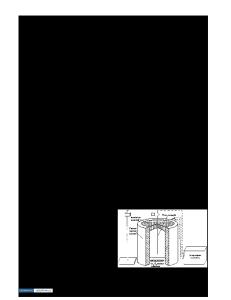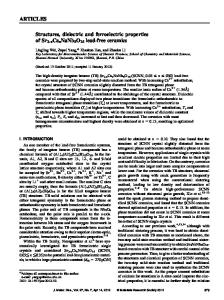Effect of Ta 2 O 5 on Dielectric Properties of Forsterite Ceramics
- PDF / 511,481 Bytes
- 6 Pages / 595 x 842 pts (A4) Page_size
- 80 Downloads / 308 Views
G3.9.1
Effect of Ta2O5 on Dielectric Properties of Forsterite Ceramics Dong-Young Kim, Hong-Yeol Lee, Dong-Suk Jun, and Sang-Seog Lee Basic Research Lab., Electronics and Telecommunications Research Institute, 161 Gajeong-dong, Yuseong-gu, Daejeon, 305-350, Korea ABSTRACT For
the
millimeter-wave
dielectrics,
forsterite-based
ceramics
were
produced.
Stoichiometric forsterite ceramics (Mg2SiO4) shows porous microstructure and very low Q*f values, which is not suitable for dielectrics in the microwave and millimeter-wave bands. The small addition (0.025 mol%) of Ta2O5 instead of SiO2 enhanced the sinterability of forsterite ceramics. The sintering temperature was reduced more than 150oC by the addition of Ta2O5. The density was greatly increased by Ta2O5 addition. The dielectric constant and Q*f of 0.025 mol% Ta2O5 modified forsterite sintered at 1500oC was 7.3 and 150,000, respectively in microwave band (8-11GHz). The dielectric constant and Q*f of the same sample measured at 55GHz was 6.7 and 179,000, respectively. Further addition of Ta2O5 decreases the sintering temperature.
INTRODUCTION Dielectric ceramics with low permitivity and high-Q have recently become of great importance. Ceramic substrate should have a low permittivity in order to minimize coupling between components and conductors on the substrate surface in the application of advanced substrate materials needed for microwave integrated circuits.[1] Since the dielectric loss is directly related to the loss of circuits, these substrate materials should have high dielectric quality factors. Recently, the millimeter wave band over 30GHz has been actively investigated as a next generation wireless communication system.[2] In accordance with the development of millimeter wave communication system, demands for devices and dielectric materials used in millimeter wave bands are gradually increased. However, there are few reports on the dielectric properties in millimeter-wave bands. Due to its dielectric properties of high Q and low dielectric constant in MHz range, forsterite ceramics (2MgO-SiO2) has been considered as one of the important candidate dielectric material for millimeter wave bands. However, the sintering temperature is too high in order to produce forsterite with high Q. In present study, forsterite was mixed with Ta2O5 in order to enhance the dielectric properties and to reduce the sintering temperature. The effect of Ta2O5 addition on the sintering
G3.9.2
temperature and microwave and millimeter-wave dielectric properties of forsterite ceramics are reported.
EXPERIMENTAL DETAILS High purity (Kojundo chemicals laboratory, Japan, 99.9%) MgO, SiO2, Ta2O5 were used as raw materials. The powder mixture of forsterite composition [2MgO-(1-x)SiO2-(x/2+y),Ta2O5] was ground for 20 hours in a polyethylene bottle with distilled water and zirconia balls. The mixture was dried for 20 hours in drying oven at 110oC. The dried powder was calcined in a high purity alumina crucible at 1250oC for 4 hours. The calcined powders were performed a second at
Data Loading...











